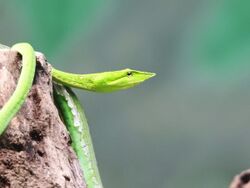Biology:Ahaetulla oxyrhyncha
| Indian or Long-nosed vine snake | |
|---|---|

| |
| At Nehru Zoological Park, Hyderabad | |
| Scientific classification | |
| Domain: | Eukaryota |
| Kingdom: | Animalia |
| Phylum: | Chordata |
| Class: | Reptilia |
| Order: | Squamata |
| Suborder: | Serpentes |
| Family: | Colubridae |
| Genus: | Ahaetulla |
| Species: | A. oxyrhyncha
|
| Binomial name | |
| Ahaetulla oxyrhyncha (Bell, 1825)
| |
The Indian vine snake or long-nosed vine snake (Ahaetulla oxyrhyncha) is a species of diurnal, mildly venomous, arboreal snake distributed in the lowlands of peninsular India.Often mistakenly believed to peck out peoples' eyes, this misconception has led to widespread wanton killing of this species.[1][2][3]
Description
A thin and slender-bodied snake that is usually bright grassy green in colour. A pair of white lines extend throughout its body length demarcating the back and under belly parts. Adults reach over 5 feet (1.5 m) in length. They have unique horizontal pupil in the eye. Formerly misclassified as A. nasuta, A. oxyrhyncha is actually a much larger-bodied species that also has a much longer snout.[3]
Geographic range
This species is distributed throughout the drier plains and low hilly tracts of Peninsular India , except the Western Ghats rainforest. [1]
Habitat
It is found in many types of vegetation including arid to semi-arid habitats and in dry deciduous forests, as well as open areas such as scrub forests, coastal forests, and Indian savannah. This species has been often sighted in and around human habitations in villages and countrysides and even in some city Parks.[1]
Taxonomy
It was described as a distinct species in 1825 based on drawings of snakes from Vishakapatnam, but later considered as same species and confused with A. nasuta, that is only endemic to Sri Lanka. A 2020 study found A. nasuta to be a species complex of A. nasuta sensu stricto and several species endemic to the Western Ghats (A. borealis, A. farnsworthi, A. isabellina, and A. malabarica).[1]
References
- ↑ 1.0 1.1 1.2 1.3 Mallik, Ashok Kumar; Srikanthan, Achyuthan N.; Pal, Saunak P.; D’souza, Princia Margaret; Shanker, Kartik; Ganesh, Sumaithangi Rajagopalan (2020-11-06). "Disentangling vines: a study of morphological crypsis and genetic divergence in vine snakes (Squamata: Colubridae: Ahaetulla ) with the description of five new species from Peninsular India" (in en). Zootaxa 4874 (1): zootaxa.4874.1.1. doi:10.11646/zootaxa.4874.1.1. ISSN 1175-5334. PMID 33311335. https://www.biotaxa.org/Zootaxa/article/view/zootaxa.4874.1.1.
- ↑ Staff Reporter (2020-11-14). "New species of vine snakes discovered" (in en-IN). The Hindu. ISSN 0971-751X. https://www.thehindu.com/sci-tech/energy-and-environment/new-species-of-vine-snakes-discovered/article33097126.ece.
- ↑ 3.0 3.1 "The discovery of five new species of vine snakes in India" (in en). https://phys.org/news/2020-11-discovery-species-vine-snakes-india.html.
Wikidata ☰ Q102109393 entry
 |


